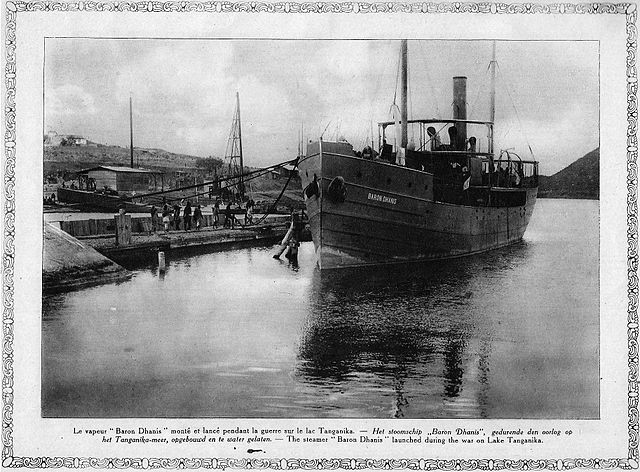
Baron Dhanis, Belgian gunboat converted from Lake Tanganyika
Some diparate countries will be studied here: It should not be forgotten that many European nations were created or resurrected (outside of Belgium) at the end of the war with the fall of the great empires: In Europe especially, Yugoslavia, Poland, the three Baltic States, Estonia, Lithuania, Latvia, Yugoslavia, and Albania. For the rest, Haiti, the French-speaking Black Republic of Hispaniolia, neighbor of St Dominic had to ensure its defense by some valuable units, Cambodia, French protectorate just like Morocco, Persia and Egypt, recovering territories after the fall of the Ottoman Empire.
 The Belgian Navy:
The Belgian Navy:
In 1914 the Belgian Naval Force did not include any squadron of the high seas but a handful of rapid gunshields employed by the government and often unarmed (a dozen will be at the beginning of hostilities), and the old City of Antwerp ( 1864), the only specialized fishery guard. On Lake Tanganyika, during the war, she will also have the torpedo boat at Spar Netta (1915), a patrol boat on Lake Kiru, the gunboat Paul Renkin who operated in the Congo, and the torpedo boat Vankerhoven on the Nile. It was not until the occupation of flanders by the Germans and the establishment of efficient and well-protected naval bases that the government became aware of the usefulness of a small coastal naval force, which it developed at from 1919 thanks to allies with disparate ships.
 The Cambodian Navy:
The Cambodian Navy:
Protectorate French since 1863, she defended with a semblance of navy constituted by the old gunboat Lutin dating from 1874 and also used as a royal yacht, and two other gunboats (civilian steam of 80 tons), armed with a single light gun as well as three other armed vapors assisted by about thirty armed junks. In case of attempted invasion, France had a squadron on site.
The Cuban Navy:
Since its independence in 1898, this ancient “Pearl of the Spanish Empire”, had the economic resources to build a force as important as that of Haiti, not far from there, but not the necessary, because a few cables, the US Navy could intervene on what was then its “preserve”, and did not stop doing it… eight times. The port of Havana had become an annex naval base of the US Navy.
In 1911, was launched at the Cramp Yards a 2000 tons sloop, naturally called Cuba and another small gunboat ordered at the same time, the Patria. The Cuban government also ordered the two small gunboats of the Diez de Octubre class at the same site, and built two 80 ton wooden steamers locally (Habana and Pinar del Rio in 1912). These were added to the 8 small steamers (less than 50 tons) used as a guard fishery.
In 1917, Cuban neutrality shifted, always in the bosom of the big neighbor, into an open hostility with Germany. This enabled him to seize in his ports four large German steamers of more than 19 000 GRT, quickly entrusted to the good care of Uncle Sam. The Caribbean sector, with a fairly large traffic, was not directly involved in the England and the U-Bootes did not come to venture there, however, the Cuban gunboats patrolled there in agreement with the US Navy. Four wooden submarine hunters of the “110 feet” type were allocated to his “fleet” in 1918.

The Baire in 1914, its peacetime livery.
The Baire was at the beginning of the century, the only ship of importance in the Cuban “fleet”, which also had only a few peach guards. The Baire was paradoxically built in Germany, in Schichau, launched in 1906, and served until late in the years 35-36.
Displacement (1908): Displacement & Dimensions 500t; 59.74 x 7 x 2.74m
Propulsion 1 propeller, 1 mach. vap. Babcock boiler, 1200 hp. and 14 knots max.
Armament 2 x 57 mm, 2 x 47 mm guns.
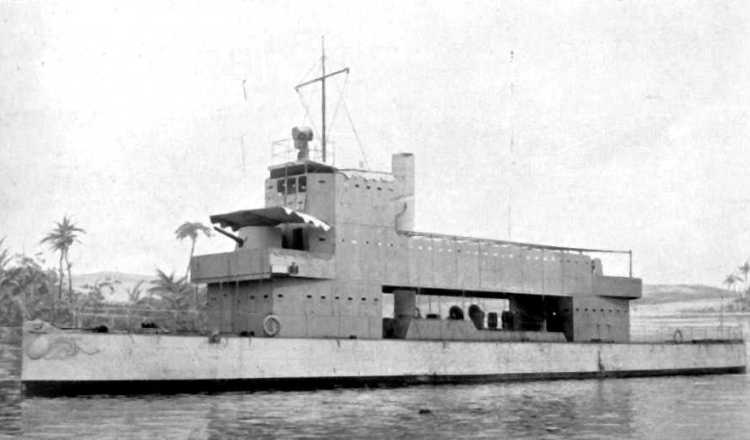
Egyptian gunboat Melik
 The Egyptian Navy:
The Egyptian Navy:
Apart from some old yachts of armed servitude on the nile (Dahabieh in particular), the “flotilla” of caliph Ismail I included only three gunboats dating from 1863 to 1865. From 1882, the British seized the Egypt to control the Suez Canal, although the country remained under Ottoman jurisdiction. The effective control of the British made Egypt officially warring against the central empires. his fleet was not a necessity in view of the forces deployed locally by the triple agreement. Numbers: Gunboats Karthoum, Dongola and Jeafferieh (1862-65), retired from service at the end of 1914, 6 coastguards, Noor el Bahr, Nesim, Marda, Zarif, Saria and Abbas, dating from 1884 to 1891. The last was torpedoed by the U35 in Bay of Solloum in Nov. 1915. Armed Yachts Mahroussa, Emirighain, and Abdul Monaym (1865-1902). There were also 10 gunboats on the Nile, 4 of the Tamai class (1884), 3 of the El Zafir class (1896) and 3 of the Sultan class (1896).

Crete a pierot, Haitian gunboat.
 The Haitian Navy:
The Haitian Navy:
A highly indebted country, he built himself a relatively powerful navy for his low income, and his buildings had the opportunity to fight against his debtors, especially Germans. In 1903, for example, the gunboat Panther sank as a result of a commitment Crete to Pierot. In 1914, Haiti was neutral and was not interested in anyone. His forces included a cruiser, the ex-Umbria Ferrier, acquired in 1911 from Italy, but the latter sank in 1913 due to the inexperience of his crew. She had 4 gunboats, Dessalines (1883), Toussaint-Louverture (1886), and 2 Capois Death (1893). In 1915, US Marines landed in Haiti when the lack of funds government disintegrated and it was chaos. The latter remained there until 1934. All gunboats were sold to scrap metal and the Haitian navy disappeared. This did not prevent the new government under guardianship from declaring war on Germany in July 1918.

Rare photo of Persian Persepolis gunboat 1886 (hippostcard.com)
 The Persian navy:
The Persian navy:
In 1886 the Persepolis gunboat was acquired as was the German Susa river patrol boat, constituting the nucleus of a naval force. Due to the lack of competent local personnel, German sailors and officers employed them. But lack of maintenance funds the ships were neglected and were quickly in poor condition. The crews returned to France and the ships rotted at the dock, a fate comparable to the Turkish navy. Muzaffer gunboat and the Royal Selika yacht were added in 1899. The Persians remained neutral, but their ships were occasionally used by the Royal Navy in the Indian Ocean.
 Venezuelan Navy
Venezuelan Navy
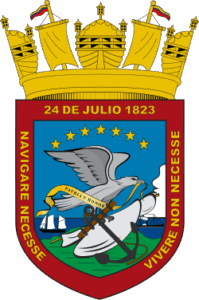 The Bolivarian Navy of Venezuela (Armada Bolivariana de Venezuela or ABV) was one of the earliest in South America, a creation of 1811, with the Venezuelan War of Independence. Originally this was a small coastal force made of a ragtag assembly of schooner and other sailing vessels armed with field guns. By May 1810, Commander Lino de Clemente (a veteran officer of the Spanish Navy) joined the insurrection in the April 1810 coup against the colonial government.
The Bolivarian Navy of Venezuela (Armada Bolivariana de Venezuela or ABV) was one of the earliest in South America, a creation of 1811, with the Venezuelan War of Independence. Originally this was a small coastal force made of a ragtag assembly of schooner and other sailing vessels armed with field guns. By May 1810, Commander Lino de Clemente (a veteran officer of the Spanish Navy) joined the insurrection in the April 1810 coup against the colonial government.
Later he became appointed the first Minister of Defense and his tasks included the creation of a navy. In April 1811 her ordered the creation of the Nautical School. Ensign Vicente Parrado became first superintendent, established at La Guaira. It was to train future naval officers, months even before the formal Declaration of Independence. The first vessels used by this force was ended the Captaincy General of Venezuela. It took part in the first actions in the campaigns in Guayana in 1811-12, with a baptism of fire for the fledgling naval service. Colonel Antonio Mendoza was first commanding general.
Having mostly obsolete vessels, they were still maintained properly by well drilled crews.
Creation of the Venezuelian navy (1811-1870)
 The history of the venezuelian Fleet Command is intertwined with the history of the Bolivarian Navy. The first ensign was raised as early as March 12, 1806, as part of the expedition of Admiral Francisco de Miranda, for the Venezuelan independence, flown from the sailing ships Leander, Bee, and Bacchus. Until 1883, including the pre-independence period, War of Independence, consolidation of the Republic, the Naval Forces were also calle the “squadron”, or “naval expeditions”.
The history of the venezuelian Fleet Command is intertwined with the history of the Bolivarian Navy. The first ensign was raised as early as March 12, 1806, as part of the expedition of Admiral Francisco de Miranda, for the Venezuelan independence, flown from the sailing ships Leander, Bee, and Bacchus. Until 1883, including the pre-independence period, War of Independence, consolidation of the Republic, the Naval Forces were also calle the “squadron”, or “naval expeditions”.
On May 4, 1810, the Supreme Junta of Caracas appointed Lino de Clemente Secretary of the Navy and War. He promoted the creation of the Venezuelan Navy in 1811 and by March 1811, Colonel Juan Bautista Arismendi tried to contain the advance of the Spanish through Guyana with his newly formed naval force on the banks of the Orinoco. There were mostly gunboats and small boats unable to breal the Spanish coastal blockade by the Regency Council of Cádiz, but perfect for a riverine guerilla and playing their part in the Guyana Campaign (1811-1812). On August 23, 1811, the naval battle of Chichiriviche (independence war) was the first official battle in which the yound navy took part. After the victory, the fleet besieged several ports on the Orinoco River until the crushing defeat at the Naval Battle of Sorondo in February 1812.
In 1813, General Arismendi reorganized the force by acquiring three schooners and other smaller vessels, creating a new fleet of 14 vessels, under the command of Italian privateer Giovanni Bianchi. Later in 1813, another force was created, comprising the brig Arrogante Guayanés, the schooners Colombiana, Perla Carlota, and Mariño, gunboat Independencia, and xebec General Piar. In September 1813, Colonel Santiago Mariño these these seven ships under ommand of Colonel Manuel Carlos Piar (later Admiral Piar) to blockade Puerto Cabello. José Francisco Bermúdez also carried out naaval incursions. The xebec General Piar defeated the royalist brigs Alerta and Celoso in the action of November 13, 1813, between Puerto Francés and Chuspa. The Spanish retreated to Puerto Cabello. From La Guaira, a new force was creating with the war schooners Atrevida and La Juana, launches Venturosa and Ligera. In 1814, another was created at Cumaná on August 25 (schooner Jove, Intrépido Bolívar, La Colombiana, El Centauro, La Carlota, La Culebra, Arrogante Maturines). Thanks to their naval bombardment and landing of troops, the Republicans were defeated the Royalists at Pampatar and Venezual fell back under Spanish control.
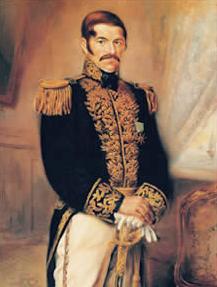 Cartagena de Indias fell in 1816, and Simón Bolívar granted Admiral Luis Brión full authority to reorganize the Navy, with the first naval officers instructed at La Guaira. There was an operation to invade Venezuela from the Antilles. By March 1816, exiled patriots in Haiti organized the Cayos expedition: The schooner Bolívar (6 guns flagship, Renato Beluche), schooner Mariño (Thomás Dubouille), schooner Piar (20-gun, John Parnell), schooner Brion (4 guns, 10 carronades, Jean Monier); schooner Feliz (Charles Lominé), schooner Conejo (18-gun, Bernardo Ferrero) under overall command of Admiral Luis Brión (pic). From Los Cayos de San Luisthey arroved at Margarita Island, and met patrolling Spanish ships near the Los Frailes archipelago. The brig “Intrépido” and schooner “Rita” were soundly defeated at the naval battle of Los Frailes, incorporated into the expedition. Next was the the Guyana campaign, with the Republican squadron in operations on the Orinoco River, Apure River, chasing out or capturing all royalist ships, besieging Angostura and other cities by sea and land, capitulating shortly after.
Cartagena de Indias fell in 1816, and Simón Bolívar granted Admiral Luis Brión full authority to reorganize the Navy, with the first naval officers instructed at La Guaira. There was an operation to invade Venezuela from the Antilles. By March 1816, exiled patriots in Haiti organized the Cayos expedition: The schooner Bolívar (6 guns flagship, Renato Beluche), schooner Mariño (Thomás Dubouille), schooner Piar (20-gun, John Parnell), schooner Brion (4 guns, 10 carronades, Jean Monier); schooner Feliz (Charles Lominé), schooner Conejo (18-gun, Bernardo Ferrero) under overall command of Admiral Luis Brión (pic). From Los Cayos de San Luisthey arroved at Margarita Island, and met patrolling Spanish ships near the Los Frailes archipelago. The brig “Intrépido” and schooner “Rita” were soundly defeated at the naval battle of Los Frailes, incorporated into the expedition. Next was the the Guyana campaign, with the Republican squadron in operations on the Orinoco River, Apure River, chasing out or capturing all royalist ships, besieging Angostura and other cities by sea and land, capitulating shortly after.
Venezuelan sailors like Brión and his brothers Antonio, Domingo and Fernando Díaz would have an important role in the success of the campaign.
During the independence, privateers were highly active, fighting for both sides and in many cases (especially early years), made for a larger naval force than regular ones. Venezuelan privateers operated throughout the Caribbean, as far as the Atlantic, coasts of Spain. They captured Amelia Island in 1817 under the command of Gregor MacGregor, with regular Venezuelan officers, and captured Fort San Carlos de Fernandina, proclaiming the independence of Florida. In 1822, General Francisco de Paula Santander created the first Marine Infantry Battalion. In 1823 took place a major naval offensive in Zulia to defeat Francisco Tomás Morales under command of Admiral José Prudencio Padilla (Marine Infantry under General Manuel Manrique). They forced the Maracaibo bar, entered Lake Maracaibo, caotured but abandoned. On July 24, 1823, the Battle of Lake Maracaibo took place (largest naval battle of the independence) seein Admiral Padilla’s squadron facing the Spaniards led by Admiral Ángel Laborde. Victory later secured the defeat and capyiulation of Morales’ armies.
The separatist Venezuelian Navy
When Venezuela separated from Gran Colombia, there was stark reduction due to a tense fiscal situation, political instability. In 1845, the sailing vessels were graduallt replaced by steamships, with the acquisition of the brigs Presidente, Ávila, and Congreso, schooners Fama, Democracia, Trimer, Eclipse, Intrépida, Estrella, Forzosa, and Bolivariana, brig Manzanares and a small cutter named Libertador. Next was the major major modernization of 1863 with new steamers and gunboats acquired by Navy Minister Manuel Ezequiel Bruzual: Bolívar, Maparari, Mariscal Sucre, and Monagas. Then under Antonio Guzmán Blanco, the Navy experienced a further increase. In 1880, were acquired the steamers República, Reivindicador, and Remolcador, schooners Ricaurte, Sucre, and 3 de Agosto. Then arrived the steamers Libertador, Guzmán Blanco, and Lola, schooners Bolivariana, Carabobo, Washington, and Ana Jacinta.
Venezuela before WWI
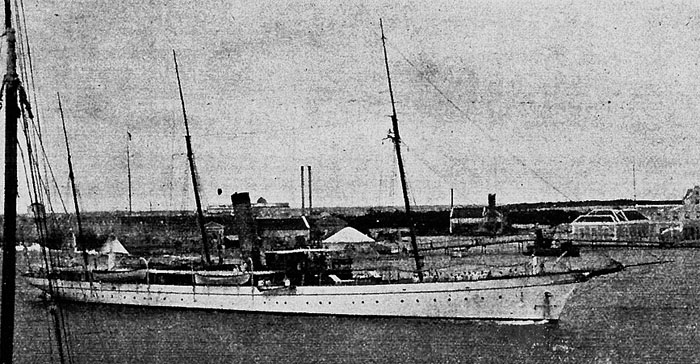
In 1900, the Venezuelan Navy acquired the “cruiser” Restaurador former US yacht Atalanta, the torpedo gunboat Bolívar (former Spanish torpedo gunboat Galicia), transport Zamora (former Spanish torpedo gunboat Filipinas), steamers Veintitrés de Mayo, Totumo, and Mariscal Sucre (former Reivindicador), gunboats Miranda and General Crespo, schooner Carabobo, and other smaller vessels. However they were all captured, hijacked, disarmed or disabled/sunk in the 1902-1903 naval blockade of Venezuela.
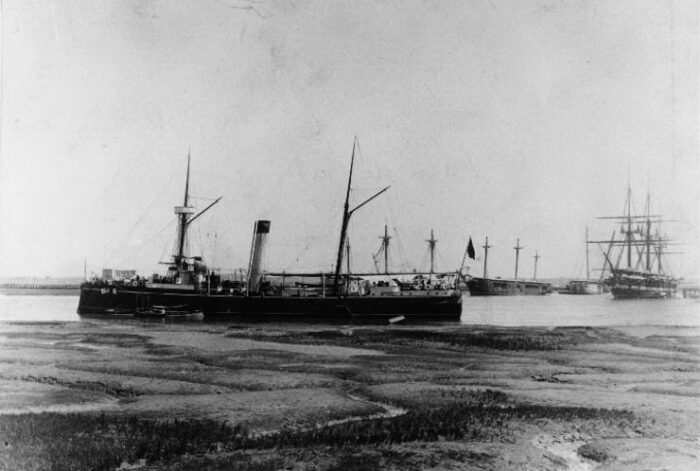
Cruiser Mariscal Sucre, former USS Isla de Cuba of the US Navy, which previously in the Spanish Navy.
According to Conways:
-The most potent ship at the time was the Gunboat “Bolivar”, a 571t vessel, ex Spanish Galicia (1891). It had a ram and some armour, acquired in 1898 and only discarded in 1920.
-The Miranda (1895) was the former Spanish 200t ship of the same name built in britain at Clydebank and sold in 1898, discarded in the 1930s
-Restaurador (launched 1884)was a flush decked gunboat with clipper bow, two masts, ex Philadelphia built Yacht Atlanta purchased in 1900 and armed with a 12-pdr and four 6(pdr guns. It measured 240 feet for 26 x 13 feet (73.15 x 7.92 x 3.96m) with a 1900 ihp machinery, 10 knots, 200t coal. Seize by the German Navy in 1902, recom. and later returned in Fbebruary 1903, renamed General Slom in 1920, discarded 1930.
-Jodé Felix Ribas: A Gunboat launched in 1894, flushed deck, one funnel, ex tug Zumbador, purchased and armed, renamed in 1903. In 1910 she was renamed Zumbador and was discarced in the 1930s.
A National naval production was setup in 1909, laying the keel of the Coast Guard cutter 29 de Enero at Puerto Cabello shipyard. A class of three (Cristóbal Colón, Ciudad Caracas) was built. In 1912, the ex-US, ex-Spanish “cruiser” Isla de Cuba was renamed Mariscal Sucre.


 Latest Facebook Entry -
Latest Facebook Entry -  X(Tweeter) Naval Encyclopedia's deck archive
X(Tweeter) Naval Encyclopedia's deck archive Instagram (@navalencyc)
Instagram (@navalencyc)


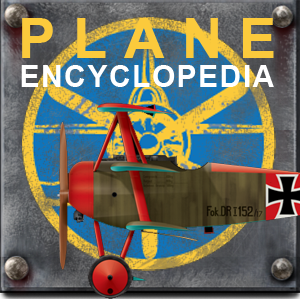
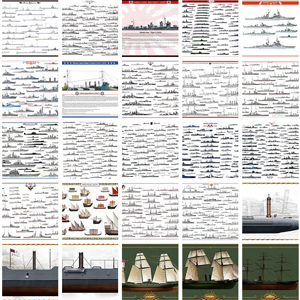

 French Navy
French Navy Royal Navy
Royal Navy Russian Navy
Russian Navy Armada Espanola
Armada Espanola Austrian Navy
Austrian Navy K.u.K. Kriegsmarine
K.u.K. Kriegsmarine Dansk Marine
Dansk Marine Nautiko Hellenon
Nautiko Hellenon Koninklije Marine 1870
Koninklije Marine 1870 Marinha do Brasil
Marinha do Brasil Osmanlı Donanması
Osmanlı Donanması Marina Do Peru
Marina Do Peru Marinha do Portugal
Marinha do Portugal Regia Marina 1870
Regia Marina 1870 Nihhon Kaigun 1870
Nihhon Kaigun 1870 Preußische Marine 1870
Preußische Marine 1870 Russkiy Flot 1870
Russkiy Flot 1870 Svenska marinen
Svenska marinen Søværnet
Søværnet Union Navy
Union Navy Confederate Navy
Confederate Navy Armada de Argentina
Armada de Argentina Imperial Chinese Navy
Imperial Chinese Navy Marinha do Portugal
Marinha do Portugal Mexico
Mexico Kaiserliche Marine
Kaiserliche Marine 1898 US Navy
1898 US Navy Sovietskiy Flot
Sovietskiy Flot Royal Canadian Navy
Royal Canadian Navy Royal Australian Navy
Royal Australian Navy RNZN Fleet
RNZN Fleet Chinese Navy 1937
Chinese Navy 1937 Kriegsmarine
Kriegsmarine Chilean Navy
Chilean Navy Danish Navy
Danish Navy Finnish Navy
Finnish Navy Hellenic Navy
Hellenic Navy Polish Navy
Polish Navy Romanian Navy
Romanian Navy Turkish Navy
Turkish Navy Royal Yugoslav Navy
Royal Yugoslav Navy Royal Thai Navy
Royal Thai Navy Minor Navies
Minor Navies Albania
Albania Austria
Austria Belgium
Belgium Columbia
Columbia Costa Rica
Costa Rica Cuba
Cuba Czechoslovakia
Czechoslovakia Dominican Republic
Dominican Republic Haiti
Haiti Hungary
Hungary Honduras
Honduras Estonia
Estonia Iceland
Iceland Eire
Eire Equador
Equador Iran
Iran Iraq
Iraq Latvia
Latvia Liberia
Liberia Lithuania
Lithuania Mandchukuo
Mandchukuo Morocco
Morocco Nicaragua
Nicaragua Persia
Persia San Salvador
San Salvador Sarawak
Sarawak Uruguay
Uruguay Venezuela
Venezuela Zanzibar
Zanzibar Warsaw Pact Navies
Warsaw Pact Navies Bulgaria
Bulgaria Hungary
Hungary

 Bundesmarine
Bundesmarine Dutch Navy
Dutch Navy Hellenic Navy
Hellenic Navy Marina Militare
Marina Militare Yugoslav Navy
Yugoslav Navy Chinese Navy
Chinese Navy Indian Navy
Indian Navy Indonesian Navy
Indonesian Navy JMSDF
JMSDF North Korean Navy
North Korean Navy Pakistani Navy
Pakistani Navy Philippines Navy
Philippines Navy ROKN
ROKN Rep. of Singapore Navy
Rep. of Singapore Navy Taiwanese Navy
Taiwanese Navy IDF Navy
IDF Navy Saudi Navy
Saudi Navy Royal New Zealand Navy
Royal New Zealand Navy Egyptian Navy
Egyptian Navy South African Navy
South African Navy






























 Ukrainian Navy
Ukrainian Navy dbodesign
dbodesign